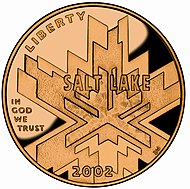 Emblem of the 2002 Winter Olympics[a] | |
| Location | Salt Lake City, United States |
|---|---|
| Motto | Light the Fire Within |
| Nations | 78 |
| Athletes | 2,399 (1,513 men, 886 women) |
| Events | 78 in 7 sports (15 disciplines) |
| Opening | February 8, 2002 |
| Closing | February 24, 2002 |
| Opened by | |
| Cauldron | Members of the 1980 U.S. Olympic hockey team, led by team captain Mike Eruzione |
| Stadium | Rice–Eccles Stadium |
Winter Summer
2002 Winter Paralympics | |
| Part of a series on |
| 2002 Winter Olympics |
|---|




The 2002 Winter Olympics, officially the XIX Olympic Winter Games and commonly known as Salt Lake 2002 (Arapaho: Niico'ooowu' 2002; Gosiute Shoshoni: Tit'-so-pi 2002; Navajo: Sooléí 2002; Shoshoni: Soónkahni 2002), were an international winter multi-sport event that was held from February 8 to 24, 2002, in and around Salt Lake City, Utah, United States.
Salt Lake City was selected as the host city in June 1995 at the 104th IOC Session. They were the eighth Olympics to be hosted by the United States, and the most recent to be held in the country until 2028, when Los Angeles will host the 34th Summer Olympics. The 2002 Winter Olympics and Paralympics were both organized by the Salt Lake Organizing Committee (SLOC), the first time that both events were organized by a single committee, and inspiring other Olympic and Paralympic Games to be organized by such since then.[1]
The Games featured 2,399 athletes from 78 nations, participating in 78 events in 15 disciplines. Norway topped the medal table, with 13 gold and 25 medals overall, while Germany finished with the most total medals, winning 36 (with 12 of them gold). The hosting United States was third by gold medals and second by overall medals, with 10 and 34 respectively. Australia notably became the first Southern Hemisphere country to ever win gold medals at the Winter Olympics.
The Games finished with a budgetary surplus of US$40 million; the surplus was used to fund the formation of the Utah Athletic Foundation—which has continued to maintain the facilities built for these Olympics. The venues have continued to be used for national and international winter sports events after the Olympics, leading to the Winter Olympics return to Salt Lake City for 2034 games.
Cite error: There are <ref group=lower-alpha> tags or {{efn}} templates on this page, but the references will not show without a {{reflist|group=lower-alpha}} template or {{notelist}} template (see the help page).
- ^ Salt Lake Organizing Committee (2002). Official Report of the XIX Olympic Winter Games (PDF). p. 35. ISBN 978-0-9717961-0-2. Archived (PDF) from the original on October 8, 2010. Retrieved October 20, 2010.